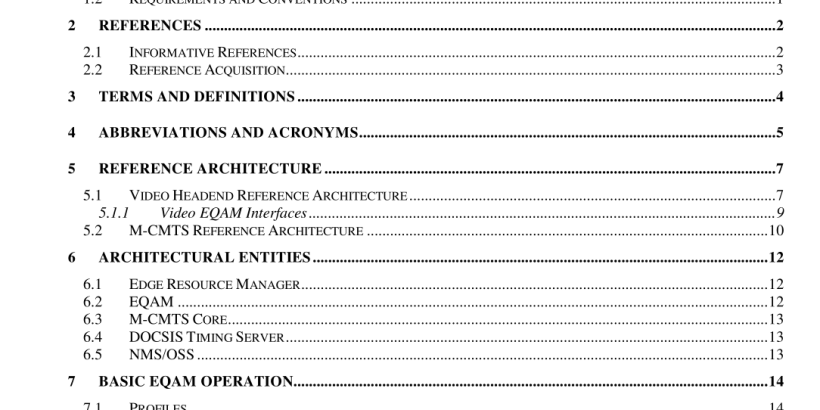ANSI SCTE 137-7-2017 pdf download.Modular Headend Architecture EQAM Architectural Overview Technical Report
5 REFERENCE ARCHITECTURE
Two reference architectures are provided in this section, one showing the digital video delivery infrastructure including video EQAMs, and the other showing the high-speed data infrastructure that includes M-CMTS EQAMs. While not explicitly shown, it is expected that the majority of MSO systems will provide both services, and even that some EQAMs will be involved in providing both services. EQAMs that are capable of delivering both digital video and DOCSIS data are referred to as Universal EQAMs.
5.1 Video Headend
Reference Architecture Cable headends acquire video from various sources to be provided to the subscriber via the HFC network. Continuously broadcast programs delivered as either analog or digital channels may feed the HFC network directly. Some linear broadcast programs may be provided as IP unicast MPEG transport streams requiring processing via an Edge QAM device in order to be continually broadcast out to the service group. Some channels may be provided as IP multicast MPEG transport streams to be only sent to service groups as needed. Finally, some video may be sourced within the headend in the form of IP unicast MPEG transport streams by video stream servers that support applications such as VOD and targeted advertising. In Figure 5-1, the dotted lines represent the video data. The remainder of the diagram represents control elements or flows within the video system.
In the video architecture, digital video that is not broadcast continuously to service groups is controlled by the interaction of a service-specific client application on the STB, signaling to service-specific session managers to request receipt of a video stream. When the STB client requests a stream of the session manager, the session manager must acquire the necessary resources that allow the stream to be transported from source to destination. In order to acquire the necessary RF/QAM bandwidth and the Edge QAM device resources to transport the stream to the service group, the session manager requests an ERM component function to allocate the bandwidth to the session manager. The ERM component function may need to dynamically provision the Edge QAM device to prepare it to receive the stream and direct it to the appropriate RF output using the allocated MPEG Program Number. The components and interfaces in the video headend are described below. The Session Manager functional component is used to establish a session with an STB client on which the client application can request video streams be directed to the STB and control the behavior of the stream. The session manager is responsible for collaborating with other components in the headend to acquire the necessary resources to insure the video stream can be delivered to the service group. The ERM functional component is used to manage the use of transport bandwidth into the Edge QAM device and HFC bandwidth out the Edge QAM device. The Session manager uses the ERM to find an Edge QAM device with an RF output having sufficient bandwidth and connectivity to the STB service group (serving area). The ERM may have to provision some resources on the Edge QAM device to prepare it to receive the input stream and forward it out the appropriate RF port.
The Edge QAM device, or EQAM for short, has one or more ingress interfaces (typically gigabit Ethernet) and multiple RF QAM outputs. The EQAM accepts input MPEG SPTSs or MPTSs transported via UDP/IP (multicast or unicast) and multiplexes these input programs into an output MPTS that is then modulated and transmitted out one of the EQAM QAM RF outputs. An EQAM that is capable of performing these functions is known as a Video EQAM. The STB receives the QAM channel by tuning to the proper frequency, and can decode a single MPEG program from the MPTS. The STB is also responsible for providing the decoded A/V stream to the subscriber output device (i.e., monitor or TV) for presentation.ANSI SCTE 137-7-2017 pdf download
